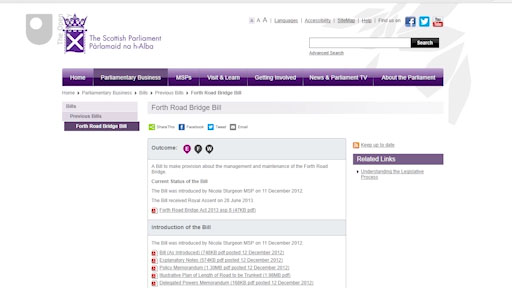3.6 Royal Assent
Section 32 of the Scotland Act 1998 provides that a Bill, once passed, must be submitted by the Presiding Officer for Royal Assent. This is done after a period of four weeks. During that time, the Bill may be subject to legal challenge by the Advocate General for Scotland, the Lord Advocate or the Attorney General, and may also be subject to an order made by the Secretary of State. The Presiding Officer may, however, submit the Bill for Royal Assent after less than four weeks if notified by all three Law Officers and the Secretary of State that they do not intend to exercise their powers of legal challenge.
Royal Assent, when the Bill becomes an Act, is treated (under Section 28(3) of the Scotland Act 1998) as taking place at the beginning of the day on which Letters Patent signed by the Monarch are recorded in the Register of the Great Seal by the Keeper of the Registers of Scotland. When Royal Assent has been given, the Clerk of the Parliament writes the date of Royal Assent on the Official Print. The Clerk also assigns an ‘asp number’ in the form ‘2017 asp 1’ (for the first Act given Royal Assent in 2017. The letters asp stand for Act of the Scottish Parliament). The Clerk then sends a certified copy of the Official Print to the Queen’s Printer for Scotland, as authority to publish the Act. The Official Print itself is sent to the Keeper of the Records of Scotland for inclusion in the National Archives of Scotland (NAS). (NAS also hold the signed Letters Patent.)
The ‘Queen’s Printer’ version of the Act, which is identical to the Official Print except the date and asp number are added, is available to the public through Stationery Office bookshops and on the OPSI (Office of Public Sector Information) website. (It is not a publication of the Scottish Parliament and therefore does not appear on the Scottish Parliament website.) The text of the Act is also sent to the Statutory Publications Office for inclusion in the electronic Statute Law Database, legislation.gov.uk.
With a Scottish Bill, the interval between the passing of a Bill and Royal Assent is less predictable in advance than it would be in relation to a Bill of the UK Parliament because of the possibility of a Law Officer’s reference under Section 33 or 34 of the Scotland Act 1998 or a Secretary of State order under Section 35 of the Scotland Act 1998. Partly for that reason, most Bills provide for a commencement date by an order made under the resulting Act.
At the same time, the Official Print version of the Act is prepared. This is produced on special archive-quality paper bound with ribbon. The Official Print is identical, in terms of its legislative text, to the Bill that was passed by the Parliament. (This is made possible by the drafting convention that, within the text of a Bill, all references are, for example, to ‘this Act’ rather than ‘this Bill’.)
You should now watch this video which explores the Forth Road Bridge.

